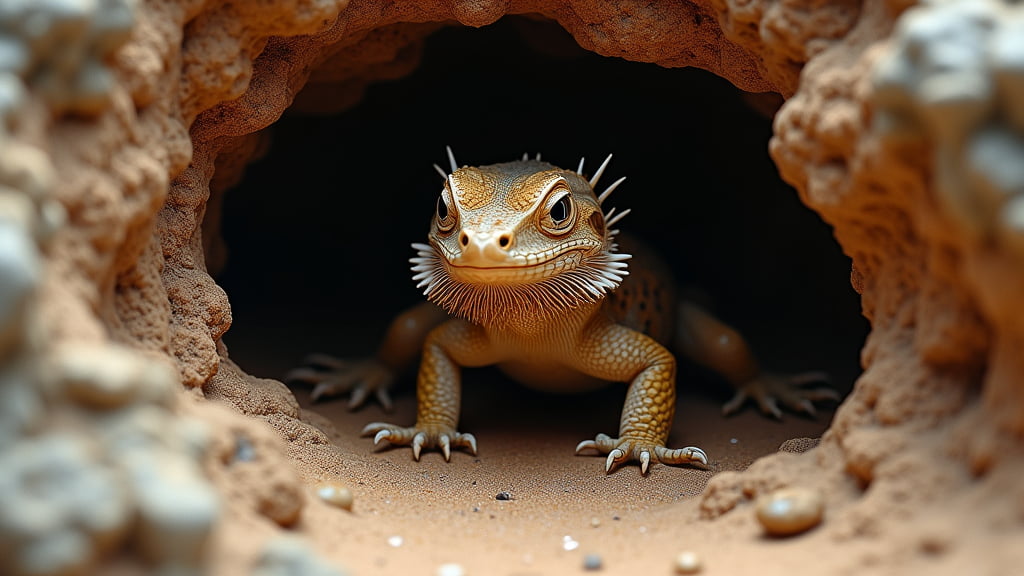Are you the proud owner of a bearded dragon, or perhaps considering welcoming one into your home? If so, it’s crucial to provide a habitat that caters to their needs, offering them not just a safe environment but also a stimulating and enriching one. One of the key elements of any bearded dragon enclosure is the hide or cave. In this blog post, we’ll delve into why hides and caves are so important, explore the different types available, and share some practical tips on choosing the best options for your scaly friend.
Why Hides and Caves are Essential for Bearded Dragons
Security and Stress Reduction
Just like us, bearded dragons need a space where they can feel secure and escape from the world. Hides and caves offer a retreat for them, reducing stress and providing a sense of security. In the wild, these creatures would naturally seek out such spots to avoid predators and harsh weather conditions. Providing similar options in captivity helps to mirror this natural behaviour, making your dragon feel at home.
Thermoregulation
Bearded dragons are ectothermic, meaning they rely on external heat sources to regulate their body temperature. A well-placed hide or cave can create a gradient of temperatures within the enclosure, allowing your dragon to move between warmer and cooler areas as needed. This is vital for their health and well-being, ensuring they can properly digest food and maintain their metabolism.
Privacy for Shedding and Sleeping
During shedding, bearded dragons often prefer a quiet and secluded spot away from prying eyes. The same goes for their sleeping preferences. Providing an appropriate hide or cave lets your dragon rest and shed in peace, contributing to their overall comfort and reducing stress levels.
Types of Bearded Dragon Hides and Caves
Natural Hides
Stone and Rock Caves
Natural hides, such as stone and rock caves, offer a robust and realistic option for your bearded dragon’s habitat. They mimic the natural environment and are usually quite durable. You can either purchase these from pet stores or find them in nature, ensuring they’re safe and clean before introducing them to the enclosure.
Wooden Logs and Branches
Logs and branches not only serve as hides but also double up as climbing structures. They blend seamlessly into the habitat, providing both a hiding spot and a playground. However, ensure the wood is free of pests and toxins. Cedar and pine, for example, should be avoided as they can be harmful to reptiles.
Commercially Manufactured Hides
Plastic and Resin Caves
Commercially available hides often come in plastic or resin materials. These are easy to clean and come in various shapes and sizes, mimicking natural forms like rocks, logs, and even tree stumps. Look for non-toxic materials to ensure the safety of your bearded dragon.
Fabric and Soft Hides
Though less common, some owners opt for fabric hides. These can be especially useful for younger dragons that may prefer something softer. However, ensure that the fabric is washable and free of loose threads that could pose a hazard.
Customisable Hides
DIY Projects
If you’re feeling creative, a DIY hide could be a fantastic project. Using safe materials such as non-toxic foam, cork bark, or untreated wood, you can design a hide tailored specifically to your dragon’s preferences and enclosure size. Just remember, safety first—ensure there are no sharp edges or small parts that could pose a risk.
Tips for Choosing the Best Hide or Cave
Size and Accessibility
Bearded dragons need enough room to move comfortably in and out of their hide. Ensure the entrance is broad enough for your dragon’s size. However, it shouldn’t be so spacious that it loses the cosy sense they seek for security.
Placement in the Habitat
Strategically place the hide in your bearded dragon’s habitat to ensure it’s accessible and functional. Position one hide in the warm area and another in a cooler spot to allow your dragon to thermoregulate effectively.
Cleanliness and Maintenance
Regular cleaning is necessary to prevent the build-up of bacteria and parasites. Opt for hides that are easy to clean or designed with removable parts. Always use reptile-safe disinfectants to clean the hides and caves.
Conclusion
Creating a comfortable and safe habitat for your bearded dragon is essential for their well-being, and hides and caves play a significant role in achieving this. Whether you opt for natural, commercial, or customisable hides, the key is to meet your dragon’s needs for security, thermoregulation, and privacy. By carefully selecting and maintaining these elements, you can ensure that your bearded dragon leads a happy and healthy life.
Meta Description: Discover the importance of bearded dragon hides and caves, explore different types, and learn expert tips on creating a safe and comfortable habitat for your pet.
For more insights and tips on bearded dragon care, don’t forget to check out our other posts and resources at Dug’s Bugs Bearded Dragon Habitat. And as always, if you notice anything unusual about your dragon’s behaviour or health, consult a vet immediately.
References:
- [Bearded Dragon Care](https://www.beardeddragon.org/articles/care/)
- [Reptile Habitat Guide](https://www.reptilesmagazine.com/reptile-habitat-guide/)
- [Safe Woods for Reptiles](https://www.thesprucepets.com/safe-firewood-list-4783949)

